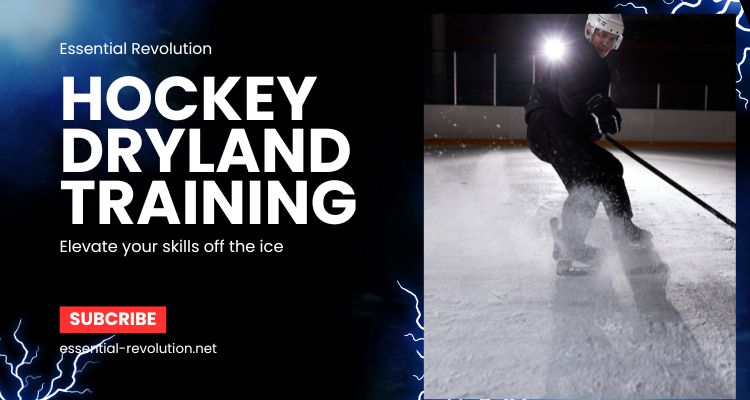Hockey dryland training is essential for players looking to enhance their on-ice performance, by incorporating specific off-ice exercises.
Hockey dryland training is a critical component for players aiming to improve their performance. By focusing on off-ice exercises, athletes can develop the physical and mental attributes necessary for success on the ice.
The Importance of Hockey Dryland Training
Hockey dryland training is crucial for several reasons:
- Strength Development: Building muscle strength is fundamental for hockey players. Dryland training includes weightlifting, resistance exercises, and bodyweight workouts that target key muscle groups used in skating, shooting, and checking.
- Speed and Agility: Off-ice drills like sprinting, plyometrics, and ladder drills enhance a player’s ability to move quickly and change directions with ease, mirroring the dynamic movements required during a game.
- Endurance: Conditioning exercises such as running, cycling, and interval training improve cardiovascular health, ensuring players maintain high performance levels throughout the game.
- Injury Prevention: Strengthening muscles and improving flexibility through dryland training can reduce the risk of injuries. This is achieved through exercises that enhance core stability and joint mobility.
- Mental Toughness: Off-ice training challenges players mentally, helping them develop resilience and the ability to push through physical and mental barriers.
Core Components of Hockey Dryland Training
Strength Training
Strength training in hockey dryland training involves exercises that target both the upper and lower body. Important exercises include:
- Squats and Lunges: These exercises focus on the legs, enhancing the power needed for explosive skating strides.
- Deadlifts: Deadlifts strengthen the back, glutes, and hamstrings, crucial for overall stability and power.
- Bench Press and Push-Ups: These exercises build upper body strength, important for shooting and puck control.
Speed and Agility Drills
Speed and agility are vital for quick transitions and maneuvering around opponents. Key drills include:
- Sprint Intervals: Short bursts of sprinting followed by brief rest periods mimic the high-intensity efforts during a game.
- Ladder Drills: These drills improve foot speed and coordination, essential for fast direction changes.
- Cone Drills: Skating patterns around cones improve agility and the ability to navigate through tight spaces.
Endurance Training
Building stamina ensures players can perform at high levels throughout the game. Effective endurance exercises are:
- Long-Distance Running: Improves overall cardiovascular endurance.
- High-Intensity Interval Training (HIIT): Combines short bursts of intense activity with rest or low-intensity periods, enhancing both aerobic and anaerobic capacity.
- Cycling: Low-impact endurance training that builds leg strength and stamina.
Flexibility and Mobility
Flexibility and mobility exercises in hockey dryland training help prevent injuries and improve overall performance. Important exercises include:
- Dynamic Stretching: Prepares the muscles for intense activity by mimicking the movements of the game.
- Static Stretching: Helps maintain flexibility and muscle length post-training.
- Yoga and Pilates: Improve core strength, balance, and overall flexibility.
Integrating Hockey Dryland Training into Your Routine
To effectively incorporate hockey dryland training into your routine, follow these steps:
- Assess Your Needs: Identify areas of improvement, such as strength, speed, or endurance, and tailor your training accordingly.
- Create a Schedule: Allocate specific days for strength training, speed and agility drills, endurance workouts, and flexibility exercises.
- Progress Gradually: Start with basic exercises and gradually increase the intensity and complexity as your fitness improves.
- Monitor and Adjust: Regularly evaluate your progress and make necessary adjustments to your training program.
- Recovery: Ensure adequate rest and recovery between sessions to prevent overtraining and injury.
Success Stories of Hockey Dryland Training
Many professional players attribute their success to rigorous hockey dryland training regimes. For instance:
- Connor McDavid: Known for his incredible speed and agility, McDavid’s off-ice training includes a mix of strength training, plyometrics, and endurance exercises.
- Sidney Crosby: Crosby’s comprehensive dryland training involves core strengthening, flexibility exercises, and specific drills to improve his shot accuracy and puck handling.
- Auston Matthews: Incorporates a blend of weightlifting, HIIT, and mobility training to enhance his performance and prevent injuries.
Tips for Effective Hockey Dryland Training
- Consistency: Regular training is key to seeing improvements.
- Variety: Incorporate different exercises to target various muscle groups and skills.
- Focus on Technique: Proper form reduces the risk of injury and maximizes the effectiveness of each exercise.
- Nutrition: A balanced diet supports muscle growth, recovery, and overall performance.
- Stay Hydrated: Adequate hydration is essential for peak physical performance.
Common Mistakes to Avoid
- Neglecting Recovery: Overtraining can lead to injuries and hinder progress.
- Ignoring Weaknesses: Focus on improving weak areas rather than only working on strengths.
- Lack of Variety: Performing the same exercises repeatedly can lead to plateaus; mix up your routine to keep progressing.
- Improper Technique: Performing exercises with incorrect form can cause injuries and reduce effectiveness.
- Inconsistent Training: Irregular training sessions won’t yield the desired results; stick to a consistent schedule.
Conclusion
Hockey dryland training is an indispensable part of any serious hockey player’s regimen. By focusing on strength, speed, endurance, flexibility, and mental toughness, players can significantly enhance their on-ice performance. Integrating a well-rounded dryland training program can lead to noticeable improvements in skill, agility, and overall gameplay. Remember, the effort you put in off the ice directly translates to success on the ice. So, lace up your training shoes and commit to hockey dryland training to elevate your game to the next level.

